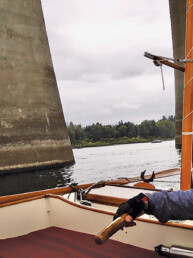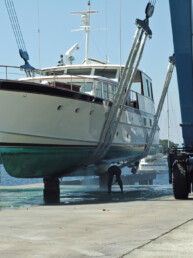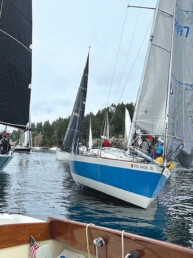When it comes to the attributes of buoyancy, most boaters have some awareness of their vessel’s displacement, ballast, and draft, as those concepts pertain to their ship’s navigation and handling. As the confidence in their boat’s stability grows, the weekend sailor may turn his or her attention towards the real, though much less life threatening area of concern — whether or not a corked bottle of wine will sink or float!
Before I could answer that age old question, I needed to explore some concepts from physics and math. Being new to sailing but experienced in those disciplines, I can utilize some formulas to calculate approximations regarding the flotation ability of seagoing vessels, from something as massive as a container ship to a boat as small as an inflatable tender. What got my wife, Laura, and I curious were the behaviors of two vessels located close to our own sailboat. Periodically anchored off the shore of our local marina are various cargo ships, either waiting to offload their containers, or to head back up Puget Sound and out to the Pacific Ocean. The waterline of these ships varies, of course, depending on the weight of their cargo. An empty ship will find its painted waterline well above the surface of the bay, while one that is fully loaded will possess a narrow band of freeboard. Sailboats will likewise behave in this manner, although the difference in the waterline between a given boat under load compared to when it is nearly empty will be minor.
The second vessel that piqued our curiosity lies at the other end of the nautical spectrum. Located at the base of the gangway in the marina which houses our sailboat, is a neglected small tender, of the zodiac variety, with the classic “U” shaped inflated pontoons. In the months that we have begun moorage, this boat has yet to be uncleated from the dock. Recently, with the the rainy season now upon us, the depth of water in the cockpit of this little boat has risen several inches, yet it appears that the “freeboard” of the boat has not narrowed much. In the case of large and small boats alike, an exploration of buoyancy can help explain the situation.
There are two main concepts that determine the buoyancy of an object: (1) The density of the object in question must be less than the density of water. The ratio of these densities is known as the specific gravity (SG) of an object. If something has an SG value less than 1, it floats; greater than 1, it sinks. And (2), if the volume of water that the object displaces weighs more than the object in question, it floats. If the object weighs more, it sinks. Specific gravity deals more with solid objects, whereas displacement usually refers to vessels that possess an open volume, like boats.
Let me use a simple block of wood to illustrate concept 1. For ease of explanation, let’s imagine a cube of wood, 1 foot, by 1 foot, by 1 foot. Furthermore, let’s suppose that this cube is a block of Western Hemlock, with a specific gravity of about 0.40. Another way to look at specific gravity is to compare the weight of a substance to the weight of an equal volume of water. So a SG of 0.40 means that, when given equal volumes of Hemlock and water, the Hemlock will weigh 40% of the water. Since a cubic foot of fresh water weighs about 62 pounds. (I say “about” 62 because the temperature of the water will affect its volume, and therefore, density. Saltwater weighs a fraction more, about 63 pounds per cubic foot, because of the minerals, aka, salt, that it contains) Therefore, the cubic foot of Hemlock should weigh about 24.8 pounds (0.4 times 62) and if placed in water, 40% of it will be submerged, with the remaining 60% above the waterline. It essentially is displacing a volume of water equal to its weight.
Since boats are not solid objects, their buoyancy can be determined by the volume of water that they displace. For example, my Columbia 28 has a displacement of 6,500 pounds. To determine the number of gallons of water equivalent to that weight, divide 6,500 by 63 pounds per cubic foot of water. The result is about 103 cubic feet. So the volume of my boat for the portion below the waterline should be about 103 cubic feet.
Now let’s see what happens when I load people and supplies aboard. The cross section of my boat can be approximated by an ellipse, or oval, in common vernacular. Since an oval is essentially a flattened circle, its area is similar to pi times r squared, or about 3.14 x radius x radius. For an ellipse, consider the distance from the center to the long “bulge” one radius, and the center to the short bulge, another. If my Columbia 28 has a simplified waterline length of 22 feet and a beam of approximately 8 feet, then the cross section area is about pi times 11 times 4 (remember, half the lengths are equivalent to a radius). The resulting area is about 138 square feet. Suppose as I’m loading supplies and family for a weekend outing to Port Townsend, I notice that the waterline of my boat has now moved up the freeboard about 2 inches, or one-sixth of a foot. The displaced volume (area of the cross section times height) is 138 times one-sixth, or about 23 cubic feet. Since a cubic foot of sea water weighs about 63 pounds, the cargo and crew weighs in at about 23 times 63, or 1,450 pounds.
The calculations could be reversed to determine the reduction in draft if one were to know the weight added to the vessel. Suppose I had 4 people (average weight 170 pounds) come aboard with a total of 200 pounds of supplies and gear. The combined weight is 4 times 170 plus 200, or 880 pounds. 880 pounds divided by 63 pounds of water per cubic foot is about 14 cubic feet. Since I calculated the cross section area of my boat at 138 square feet, I need to determine what it should be multiplied by to get a volume of 14. Using the inverse of multiplication, I should divide 14 by 138 to arrive at the change in the waterline, in feet. The result is about 0.10 feet, or 1.2 inches. So 880 pounds should lower my boat about 1 and ¼ inches. Not very significant.
The inflatable Zodiac is somewhat a hybrid of the cube of the Hemlock example and a boat. The inflated pontoons displace a large volume of contained air, (specific gravity nearly 0, about .001, since the weight of air is nearly negligible to an equal volume of water) in addition to the empty cockpit. Again, let’s simplify the volume of the shape of the pontoons, by imagining them as cylinders on their sides, bent into a “U” shape. If we were to straighten the U, the cylinder might be about 14 feet long. The volume of a cylinder is the area of its cross section, a circle, times its length. Suppose the diameter of the pontoons is one and a half feet. Then the radius would be ¾ of a foot. The area of a cross section would be pi times ¾ times ¾ or, about 1.75 square feet. Multiplying that by a length of 14 yields 24.7 cubic feet. Since each cubic foot of seawater weighs 63 pounds, the little dingy would have to weigh in at nearly 1,550 pounds to submerge the pontoons! And that doesn’t even count the volume of the cockpit. No wonder we didn’t see a change in the waterline as the boat filled up with rain!

Now for the main question. What’s going to happen to my wine when it falls overboard? While we could examine the specific gravity of the glass bottle, and the wine it contains, the most significant units for the problem are the overall weight of the bottle, wine plus glass, and the volume of the exterior dimensions of the bottle. As an approximation, the average full bottle of wine weighs about 2.65 pounds with actual fluid weighing only about 1.65 pounds (a gallon of seawater weighs about 8.5 pounds.) The volume contained in the bottle, while 750 ml in metric, is 26 ounces (US Standard), or about ⅕ of a gallon. The actual volume of the glass, while minimal, may account for about 20 cubic centimeters (remember, one millimeter is equivalent to one cubic centimeter), and there is air space and a cork, which can account for another, say, 30 cubic centimeters, resulting in an exterior volume of about 800 cc, or ml. 800 ml is about 27 ounces, or about 0.21 gallons, a little more than a ⅕ of a gallon. So, in order for the full bottle to float it would have to weigh less than the weight of an equal volume of water. ⅕ of a gallon of water weighs about 1.7 pounds (8.5 divided by 5), but the wine plus bottle weigh 2.65 pounds. Together, they weigh more than the volume of water they displace. Kiss your wine goodbye! Unless, of course, you prefer your wine in a box. Then, since the specific gravity of wine is .99, you might have a chance at rescue.

Before you start crying over the lost wine bottle, let’s consider an optimistic approach to the problem. If the bottle were not full, how much would you have to drink in order to keep it afloat (cork in, of course)? Well, the overall weight would have to be less than 1.7 pounds, the weight of water with the same volume as the bottle. We know that the bottle weighs about 1 pound, so the wine would have to weigh 0.7 pounds. 0.7 pounds of seawater weighs 0.7 divided by 8.5 pounds, about 0.08, or 8% of a gallon, which is close to 10.5 ounces. So, if you drink at least 15 ounces of wine, two big glasses, and THEN accidentally knock the bottle overboard, you just might be able to retrieve the remaining 10 ounces. The moral of the story: (1) Don’t invite too many friends onto your boat if your route takes you to shallow water, and (2), If you’re going to get careless with your wine, drink some of it first!






